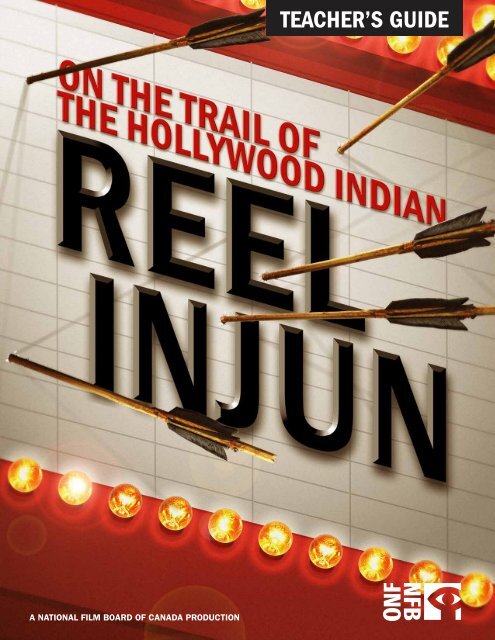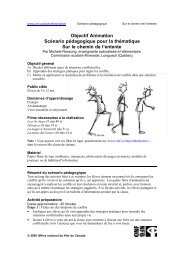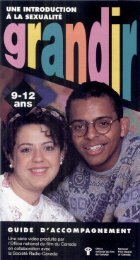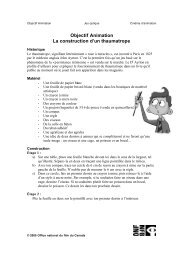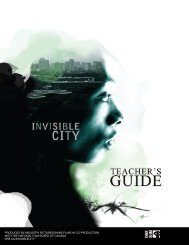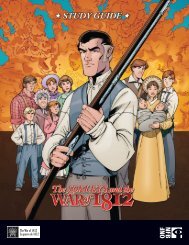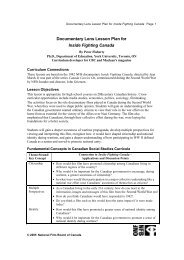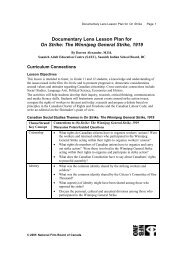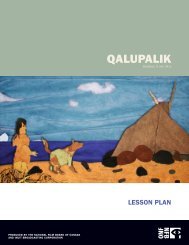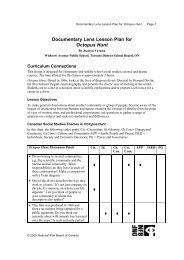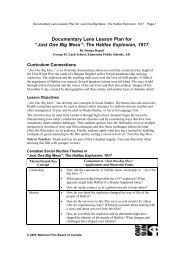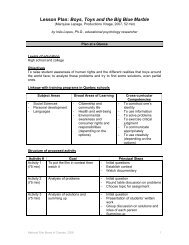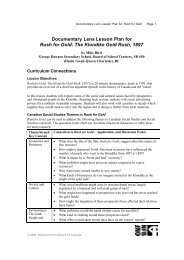TEACHER'S GUIDE - Office national du film du Canada
TEACHER'S GUIDE - Office national du film du Canada
TEACHER'S GUIDE - Office national du film du Canada
- No tags were found...
Create successful ePaper yourself
Turn your PDF publications into a flip-book with our unique Google optimized e-Paper software.
Tonto Speech and StereotypesThe Savage Injun – Chapter 4Main points: In the 1930s, Native people were portrayed as savages. Americans needed heroes, and JohnFord’s Stagecoach delivered the goods while also damaging the reputation of Native people and establishinga trend that lasted for decades: showing the savages constantly attacking the Whites. Instead ofusing actual Native languages, Hollywood developed the Tonto speech—or the art of speaking Englishbackwards—and all the big stars played Native roles (Anthony Quinn, Charles Bronson, Boris Karloff andeven Elvis Presley). After the <strong>film</strong> in<strong>du</strong>stry saddled Pocahontas with all the stereotypical notions that amythical princess deserves, she became the embodiment of American society, not of Native society, justas Hollywood dressed Native characters like Plains Indians in buckskin and headbands, even though theydo not use them in their culture.Discussion questions: By developing the Tonto speech, did Hollywood harm the existing Native languagesspoken by US tribes? Robbing nations of their identity is an act of colonialism, but why did the PlainsIndians attract more attention than the Pawnees or the Mohawks? What are some of the misguided notionssurrounding the Indian princess Pocahontas?A Violent and Racist IconThe Cowboy – Chapter 5Main points: A great icon of American cinema, John Wayne used violence with no mercy. But his actionsseemed excusable, and they set the standard for how Indians should be regarded. “The kind of hunky whiteguy representing the moral standards of America, that is not real smart and that will do the right thing,chasing the Indians away, marrying the school woman and disappearing in the sunset.” (Jim Jarmusch)Discussion questions: When John Wayne shoots a dead Indian that was <strong>du</strong>g up from a burial ground in theeyes to make sure he will not be going to the spirit world, what kind of message is Hollywood sending?What about the use of Native languages in the movies: Is it desirable in order to improve the pride andself-esteem of First Nations people?Indians or Human Beings?A Good Injun . . is it a Dead Injun? – Chapter 6Main points: As a kid, Neil Diamond did not realize that Bugs Bunny was killing Indians, and GrahamGreene was doing the same thing when he would pretend to be Gary Cooper. On the other hand, RussellMeans’ brother refused to look at the Indians being slaughtered and fought white kids outside the movietheatre. “To erase the memory of being a human being, predatory mentality uses the word ‘Indians’ soNatives will lose track of the notion of being a human.” (John Trudell)Discussion questions: Retrace the history and the meaning of this famously racist pronouncement byGeneral Philip Sheridan: “A Good Injun . . . is a Dead Injun.” Why would Hollywood use such neo-colonialistpropaganda to confuse the feelings of young Native people? Regarding the notion of human beings, whydoes John Trudell place so much emphasis on language as an instrument of war? What does it mean toyou to be a human being?TEACHER’S <strong>GUIDE</strong>4
The American Indian Movement (AIM)The Groovy Injun – Chapter 7Main points: In the 1960s, the hippies became Indians, trying to imitate them but at the same time tryingto remember who they were and where they came from. The hostility of the media towards Native peoplesub<strong>du</strong>ed their spirit somewhat, but <strong>film</strong>s like Billy Jack heralded a new fight against injustice, not just inthe movies, but in real life as well, with First Nations people politically asserting themselves by seizingAlcatraz Island and Wounded Knee to recapture their land and freedom. Hollywood would in turn cometo the rescue: Marlon Brando refusing to show up at the Academy Awards to protest against “the poortreatment of Native Americans in the <strong>film</strong> in<strong>du</strong>stry” and the FBI’s actions at Wounded Knee. SacheenCruz Littlefeather would be Brando’s messenger, asking the government to change its treatment of NorthAmerican Indians. After that turning point, pro<strong>du</strong>ctions like One Flew Over the Cuckoo’s Nest and manyothers would forever change the way “Injuns” are depicted on screen.Discussion questions: Every human being is the descendant of a tribe, and there was a time when non-Native people wore feathers and beads. Try to find out which tribe you come from and at what point inhistory you lost your feathers and beads.In the 1970s, the US government infiltrated a tribal council (on the Pine Ridge Indian Reservation in thetown of Wounded Knee) and in 1973 AIM activists seized the town. Retrace the framework of events thatled to the uprising.No More Stereotypes and Stoic IndiansThe Renaissance – Chapter 8Main points: Even though the government had wiped out the Native political movement by the 1980s, acultural artistic voice emerged, composed of Native <strong>film</strong>makers, songwriters and visual artists. SmokeSignals, directed by and starring Native people, ushered in the golden age of Aboriginal cinema. The storywas not about what occurred one hundred years ago but about current-day “nativeness,” where there areno stereotypes and no stoic Indians.After travelling the United States in search of the truth, <strong>film</strong>maker Neil Diamond found the answers hewas looking for in the Far North of Turtle Island (a.k.a. North America), in Igloolik. Atanarjuat, by ZachariasKunuk, paved the way for a new generation of storytelling. A new age of cinema was born!Discussion questions: Director Neil Diamond mentioned that he found the answers he was looking forin the North. What exactly was the object of his quest? On what basis can we say that Atanarjuat is the“most Native” movie ever made? How would you describe “nativeness” in the 21st century?REEL INJUN: ON THE TRAIL OF THE HOLLYWOOD INDIAN 5
SUGGESTED CROSS-CURRICULAR ACTIVITIESViewing and discussionYou can show Reel Injun in its entirety and discuss it with your students. If you don’t have the time, or itisn’t relevant to your course’s subject matter, you can assign the <strong>film</strong> for viewing outside of class and replaykey chapters in class. You can also select key chapters in the <strong>film</strong> to trigger classroom discussion or showchapters in conjunction with short clips of your choice from among the movies listed in the documentary.Role-playingStudents can role-play different personalities such as John Wayne, John Ford, Marlon Brando, Iron EyesCody, Graham Greene, Gary Farmer, John Trudell, Russell Means and Zacharias Kunuk and discuss therepresentation of “Injuns” in westerns.Note: This exercise will require a certain amount of research in order for the students to learn more aboutthese indivi<strong>du</strong>als and go beyond what is covered in Reel Injun.Hold a debateYou can explore ethical and historical issues by way of a debate, in which one team must attack and oneteam must defend a position. In all cases, there is no correct side. Divide the class in half. Ask the sidesto meet to develop positions (reminding them that the job is to defend the position, not what they thinkis right), or more casually simply ask students to chat for a few minutes with their neighbours. Then askone team to speak in defence of the position using arguments from the <strong>film</strong>. Ask members of the otherside to refute that position, using other arguments from the <strong>film</strong>. Some debate topics might be:• Many Native kids would never identify with the Indians in a western because they didn’t want to bethe bad guy.• Black Robe (Bruce Beresford), Dances with Wolves (Kevin Costner) and The Last of the Mohicans(Michael Mann) were made <strong>du</strong>ring the “Renaissance era” of Native portrayal in Hollywood yet thereare still some racist stereotypes in these <strong>film</strong>s.World CaféAs a conversational process, the World Café is an innovative yet simple methodology for staging conversationsabout questions that matter. These conversations link and build on each other as participants movebetween groups, cross-pollinate ideas and discover new insights into the questions or issues that aremost important in their life, work or community. The World Café can evoke and make visible the collectiveintelligence of any group, thus increasing people’s capacity for effective action in pursuit of common aims.Divide the group into a few teams and select facilitators for the teams. Assign a question to each facilitator,who will go from one team to the other with that question and take into account the most relevantinformation that emerges. Each team must answer each question; after the exercise, the facilitators willaddress their main concerns in front of the group.• Is the documentary approach used by Neil Diamond in Reel Injun valuable in terms of changingpeople’s perceptions about the mythological and one-dimensional stoic Indian?TEACHER’S <strong>GUIDE</strong>6
• Is it only because Native Americans are directing their own <strong>film</strong>s now that real change hasoccurred, or are there other reasons?• After the silent era, Native Americans were not able to show their perspectives on the screen. Whydid it take so long for them to regain control of their true image?• Why do you think Russell Means and John Trudell, famous AIM activists and Hollywood detractors,agreed to participate as actors in certain Hollywood pro<strong>du</strong>ctions (Natural Born Killers, Thunderheart,Smoke Signals)?SAMPLE TEACHING MODULES FOR CINEMA STUDIES, SOCIAL STUDIES, MEDIA ANDCOMMUNICATION, ETHICS AND HISTORYHere are some sample mo<strong>du</strong>les, organized by curriculum area for secondary school and early post-secondarystudies. You can customize the mo<strong>du</strong>les or use them as a spur to your own invention.Cinema studiesGoal: To investigate the range of narrative approaches that shaped perceptions of the Native Americanthroughout the history of cinema.View some movies that date from the “Birth of the Reel Injun” era, such as Edison’s Laguna Pueblo NativeAmerican rituals and dances, They Died with Their Boots On (Raoul Walsh), Custer’s Last Fight (Francis Ford),The Plainsman (Cecil B. DeMille), Stagecoach (John Ford) and Captain John Smith and Pocahontas (LewLanders), and from the “Groovy Injun” era, like Little Big Man (Arthur Penn), One Flew Over the Cuckoo’sNest (Milos Forman), Dead Man (Jim Jarmusch), Powwow Highway (Jonathan Wacks) and Dances withWolves (Kevin Costner), and lastly, from the “Renaissance era,” such as Once Were Warriors (Lee Tamahori),Smoke Signals (Chris Eyre) and Atanarjuat (Zacharias Kunuk). Discuss with students what they understoodto be the plot and the structure of these <strong>film</strong>s and compare the representations of the Native Americanover these different periods of time.Discuss:• What narrative strategies do the <strong>film</strong>makers employ <strong>du</strong>ringa) the Reel Injun era?b) the Groovy Injun era?c) the Renaissance era?and why?• What is required of the audience in each of these situations?• Which design elements and aesthetic choices affect the storytelling?REEL INJUN: ON THE TRAIL OF THE HOLLYWOOD INDIAN 7
HistoryThe American Indian author and historian Vine Deloria addressed Indian stereotypes and challenged whiteaudiences to take a new look at the history of American western expansionism. When Custer Died for YourSins: An Indian Manifesto (1969) was published, the American Indian Movement was gaining momentumand the book helped draw attention to the Native American struggle. Deloria worked to demythologizewhite Americans’ perceptions of American Indians.Goal: To raise awareness of Native history from the perspective of Native people.Discuss:• Begin by brainstorming and try to figure out why the American Indian Movement (AIM) came to beand what impact it had on Native struggles in the 1970s and 1980s, and continues to have today.• For each of these emblematic figures of the Native struggle—Crazy Horse, John Trudell, RussellMeans, Leonard Peltier and Sacheen Littlefeather—describe their contributions to the history ofAmerica.• On the morning of December 29, 1890, the Lakota chief Big Foot and some 350 of his followerscamped on the banks of Wounded Knee Creek. Surrounding their camp was a force of US troopscharged with the responsibility of arresting Big Foot and disarming his warriors. The scene wastense. Trouble had been brewing for months; 300 Lakota Natives were killed by the US government.Eighty-three years later, blood spilled in Wounded Knee once again. Richard A. “Dick” Wilson, theOglala Lakota tribal chairman, formed a private militia sponsored by the US government to kill AIMmembers <strong>du</strong>ring their occupation of Wounded Knee in 1973. During that period of political turmoil,some Native people, such as Anna Mae Aquash, were murdered, and others were charged for the1975 killing of FBI agents. Leonard Peltier was among those charged without any proof for thesecrimes, and subsequently received a double life sentence.What exactly happened in Wounded Knee in 1890 and in the 1970s, and why is Leonard Peltierstill in jail?• In 1979, John Trudell’s pregnant wife (Tina Manning), his mother-in-law and three children werekilled in a fire at their home on the Shoshone/Paiute Reservation in Nevada. Trudell, as well asmany other activists in the movement, still believe that the fire was not accidental. It occurredwithin twelve hours of his burning of a US flag on the steps of the FBI building in Washington, DC.Considering AIM’s short history, what is your position regarding that event? Did someone killTrudell’s family members, and if so, who was it?• The Treaty of Fort Laramie (1868) between the US and the Lakotas included provisions to returnall retired, abandoned or out-of-use federal land to the Native people from whom it was acquired.Indians of All Tribes used that treaty as the basis of their occupation of Alcatraz Island and claimedit by “Right of Discovery.” From what you know and have learned, are Native people better offfighting on political grounds and engaging in direct action or should they develop a cultural, artisticvoice to gain their right to self-determination?• Given what you have discovered about Native American history, was Crazy Horse the inspiration forthe mystical-warrior stereotype?TEACHER’S <strong>GUIDE</strong>10
REFERENCESURL Addressesaigenom.comaimovement.orgBooksBAUMAN, Zygmunt, The Making and Unmaking of Strangers, in WERBNER, Pnina and Tariq MODOOD,Debating Cultural Hybridity, London: Zed Books, 1997.DELORIA, Vine, Custer Died for Your Sins: An Indian Manifesto, New York: Macmillan, 1969.HALL, Stuart, The Whites of Their Eyes: Racist Ideologies and the Media, in BRIDGES, George and RosalindBRUNT, Silver Linings: Some Strategies for the Eighties, Lawrence and Wishart, London: 1981, pp. 7–23.HALL, Stuart, Representation: Cultural Representations and Signifying Practices, Glasgow: Sage Publications& Open University, 1997.HURST, C. E., Social Inequality: Forms, Causes, and Consequences (sixth edition), Boston: PearsonE<strong>du</strong>cation, Inc., 2007.MATTHIESSEN, Peter, In the Spirit of Crazy Horse, New York: Penguin, 1992.ROTH, Lorna, Something New in the Air: The Story of First Peoples Television Broadcasting in <strong>Canada</strong>, McGill-Queen’s University Press, 2005.FilmsIncident at Oglala: The Leonard Peltier Story, Michael Apted, 1992.REEL INJUN: ON THE TRAIL OF THE HOLLYWOOD INDIAN 11


